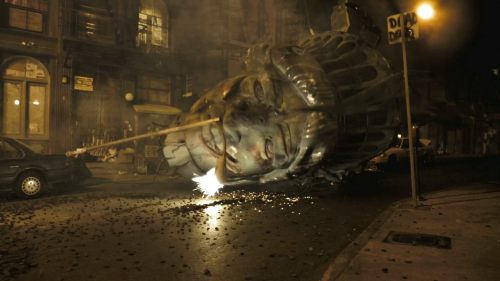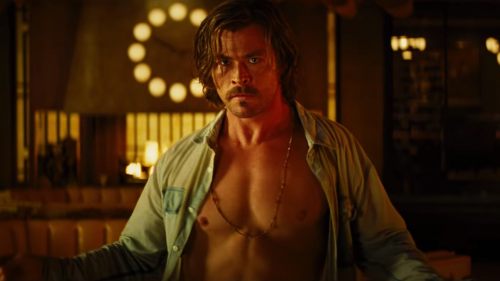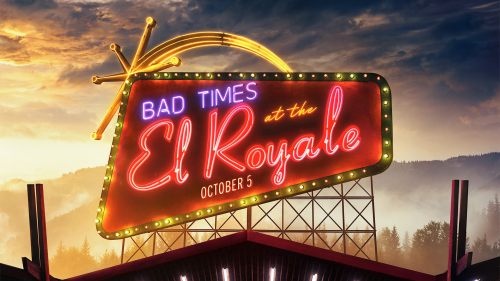Talking Classic Motel Movies With Drew Goddard
The Cabin in the Woods was the clever genre-bending and breaking debut from writer/director Drew Goddard (co-written with Joss Whedon). That film had its own extended stay on a release shelf but became a cult hit that used well known tropes of the “cabin in the woods” subgenre to redefine it.
Now Goddard is back with his second film, Bad Times at the El Royale, which gathers an impressive ensemble cast at a novelty motel that straddles the border of California & Nevada. But everything and everyone is not is as it seems.
In a similar way that Cabin was a product of the films it was a pastiche of, El Royale feels like a stylistic homage to the “hotel thrillers” subgenre. We recently sat down with Goddard to talk about some of those iconic films and how the look and feel of them influenced Bad Times at the El Royale.
James: Obviously The Cabin in the Woods and Bad Times at the El Royale are very different films, but I actually think they complement each other really well. On the surface, they're both kind of about this cast of characters isolated in this singular place, but under that surface, literally and figuratively, there's a lot more going on than what first appears.
What is it about that kind of element for you? This idea of a place like a cabin or a motel being almost a character in the film and having this kind of slick exterior and seedy interior?
Drew: Well, I always love treating environment as character. I think that's something that's always appealed to me on every project. And we really work hard and think hard about what we're looking at and where we are. When I go to movies, part of what I love is the transformative quality of film and part of that has to do with environment and the atmosphere in place. And so we treat place as a character and how we think of it, and it tends to sort of dictate location.
James: You kind of have to make this movie look really slick and stylistic, with setting it in this retro motor inn-style hotel during the late ‘60s. It's was really the heyday of that aesthetic. They were all so cool back then to where you can vividly imagine all the different postcard-like aesthetics of motor-inns.
I think hotels themselves are kind of like that. Like especially the older ones…they’re all kind of unique and have their own personalities. When you look back at this subgenre of hotel/motel thrillers, a lot of them are very evocative. They bring to mind distinct imagery right away.
I'd like to talk about a few iconic films of that subgenre and how they may have influenced Bad Times at the El Royale.
KEY LARGO (1948)
Hotel Largo
Huge influence, as well as all of the work of John Huston on this film. I think that was one of the jumping off points for this movie, especially because specifically the Key Largo it’s contained…it’s all about the contained space. You get interesting characters and then you lock them in the room and that was very much what I wanted to do with Bad Times. That the hotel very quickly has its own character. Location is everything, right? And geography. A geography is so important…where the bar is, where the rooms are, where the separation between these things are. John does such an amazing job of establishing geography so that when the dominoes start to fall, you feel it…you feel empathy with Bogart right away because you can feel how trapped he is in that situation.
PSYCHO (1960)
The Bates Motel
The thing I love…I haven't actually analyzed why this is…but you really feel unsettled right as you enter [The Bates Motel], right? As soon as you feel that hotel, it just feels off and you're with Janet and you just feel something's not right. And it's a real credit to Mr. Hitchcock how he establishes tone so quickly and so early. And I know that it's deliberate...I'm sure part of it is score...but so much of it is design and how he just keeps you claustrophobic. There's a claustrophobic aspect of that hotel that I think is very special and it kind of forces you as a viewer into the role of voyeur almost immediately. It is truly masterful what he does with that film.
THE SHINING (1980)
The Overlook Hotel
It is sort of the opposite, isn't it? Similarly, it establishes dread very quickly, but it's open. Weirdly, The Overlook is the opposite of The Bates Motel. Everything is big; the ceilings are high. You get the feeling that screams would just dissipate and no one would hear you because it's so open. There's this beautiful quality…part of it is how he shoots it too…where those hallways just feel epic and it makes the humans feel small in the corridors. You do get the sense that the hotel could just go on forever. And I think that's partly what makes it so scary. From the second they enter the hotel, the movie almost becomes allegory right away. You feel like you're watching something that's bigger than the three people in that hotel. It's about my bigger themes.
BARTON FINK (1991)
Hotel Earle
What's amazing is how it's so rooted in the time period and yet it feels entirely singular. As with a lot of Coen Brothers movies, they have such a vision for every detail, from the stationary to the way the bell rings to the shoes being put out the night before. It is impossible to overstate their influence on me as a filmmaker because I think they are just some of the greatest filmmakers in the history of cinema.
And Barton Fink was one that we screened for the crew specifically because of their willingness to establish a wholly unique environment. And you can see it from the very first second in that beautiful first shot with the way that Deakins frames everything from when Turturro walks in the front door and you just follow him and you feel the place and you feel those shafts of lights and you feel the bell ring and you end in close-up. They do a masterful job of establishing location right away. So that then by the third act, they can start deconstructing their location. And location as an extension of character is something that is very important to me. Obviously it's at the forefront of Bad Times at the El Royale - the way the location mirrors what the characters are going through in that movie is truly masterful.



